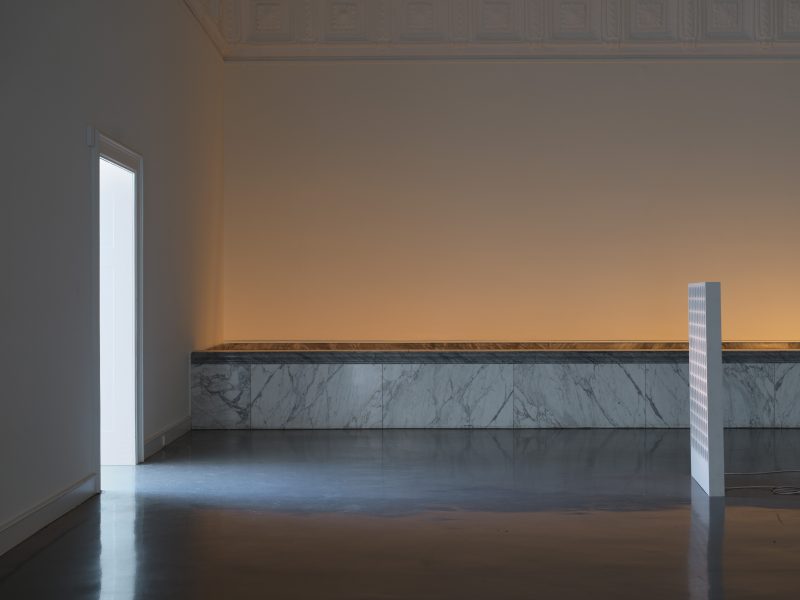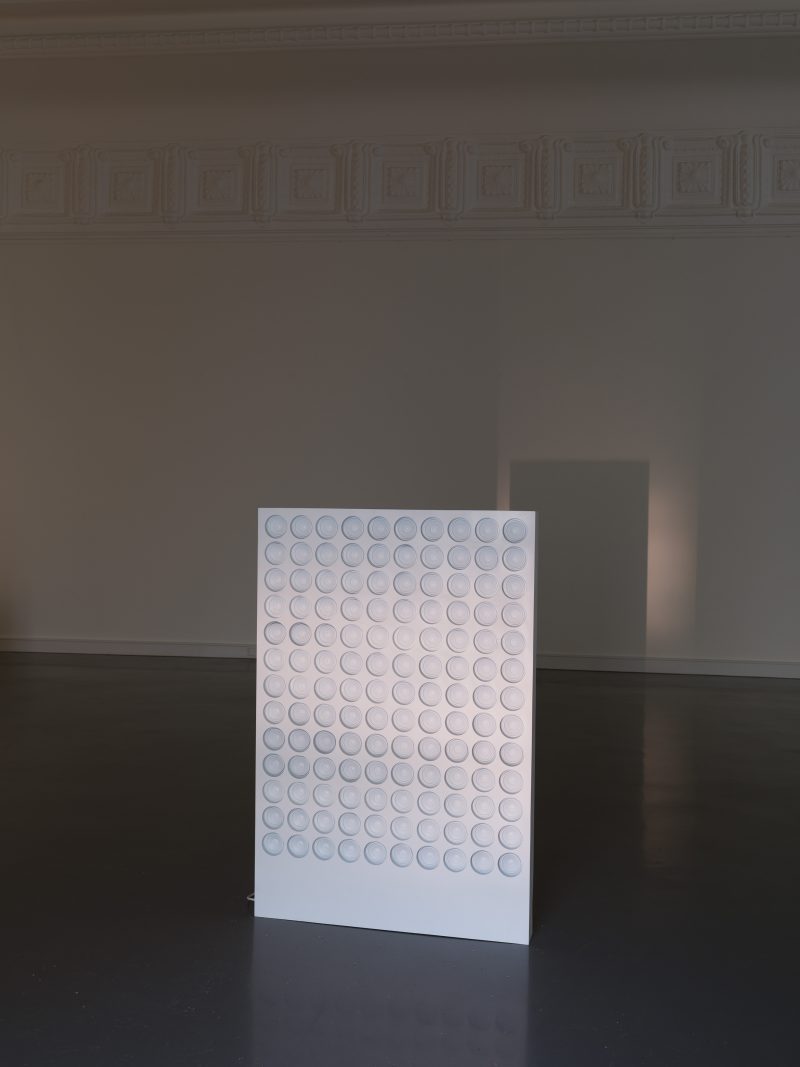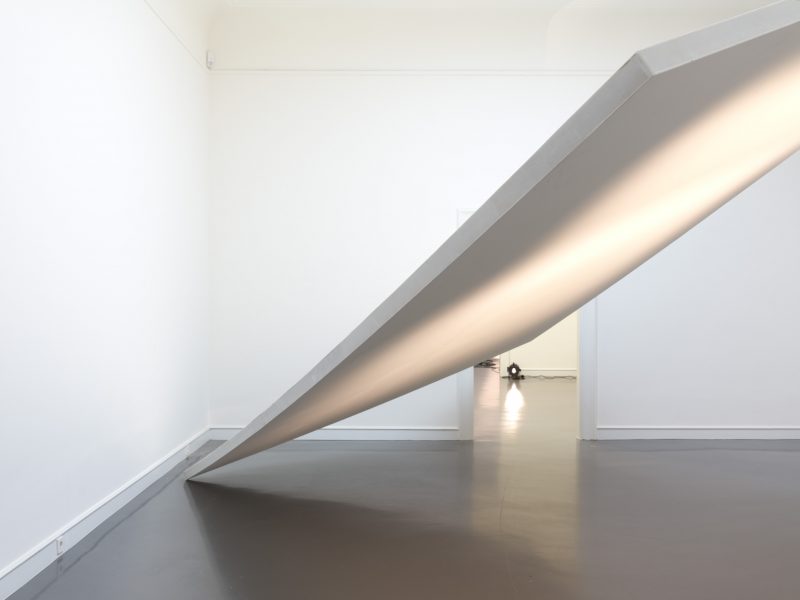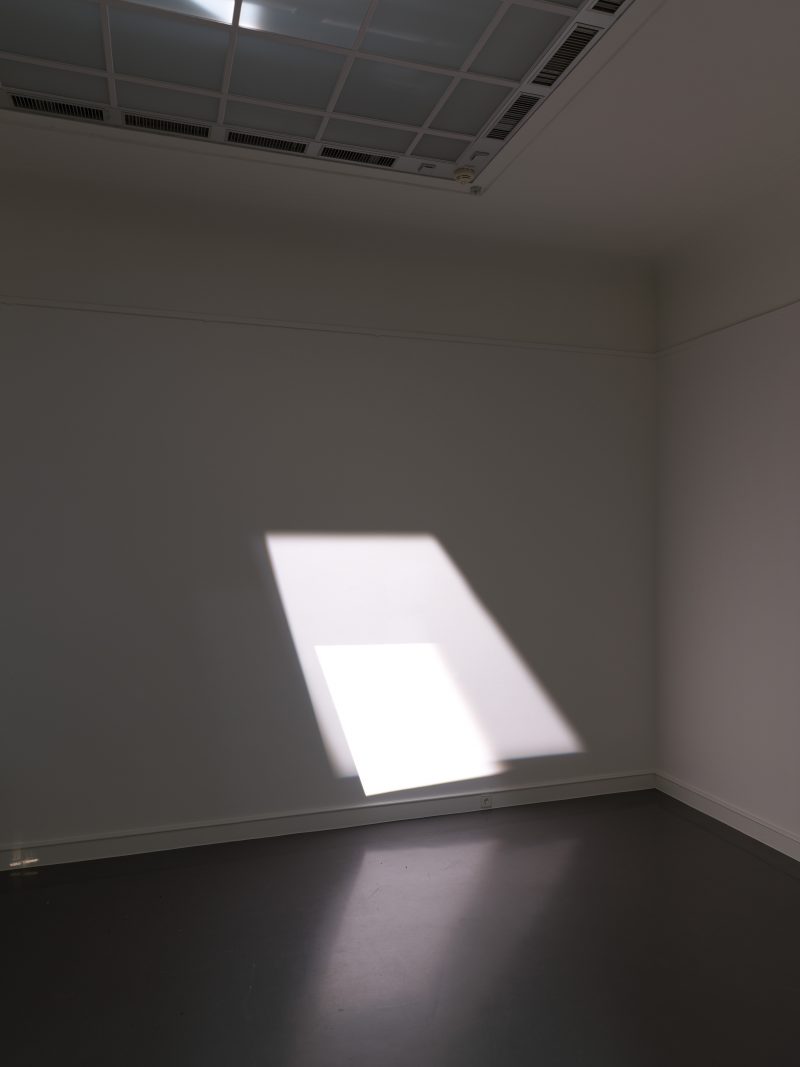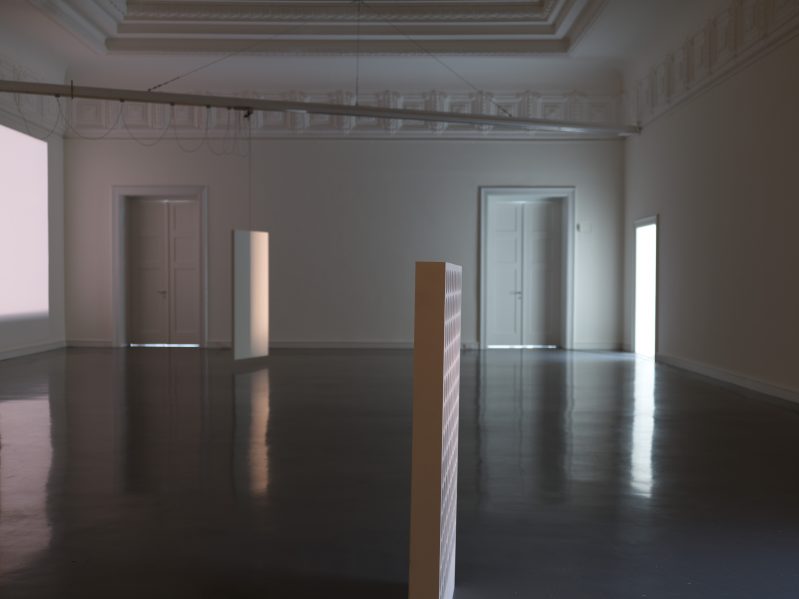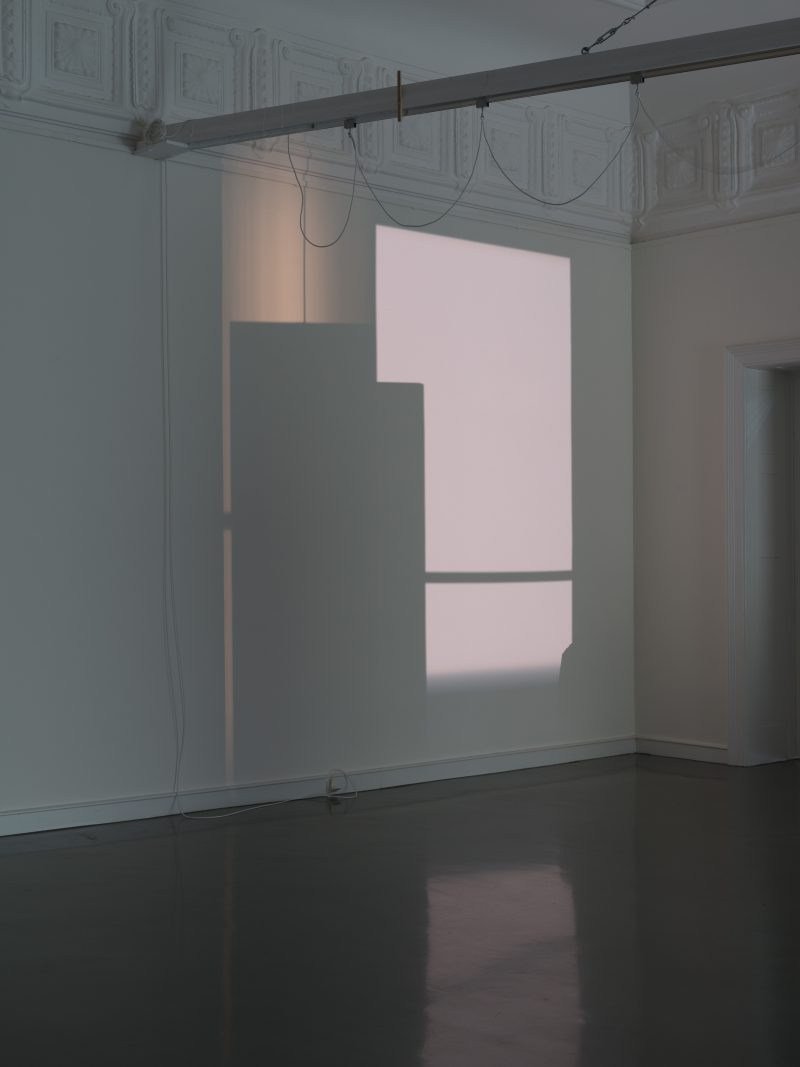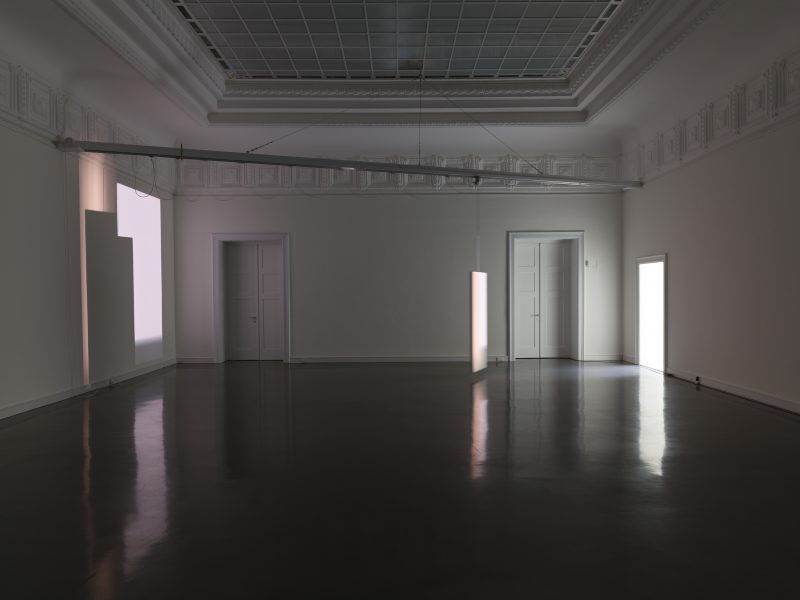Jan St. Werner
Space Synthesis
Artist
- Jan St. Werner
Curator
- Çağla Ilk
Curatorial assistance
- Sandeep Sodhi
Publication
The accompanying catalog has been published with Hatje Cantz in 2023.
With the Space Synthesis exhibition, Werner transforms the Kunsthalle into a sound space, using the building as a large instrument. The works composed for the exhibition explore human thought about sound in dialogue with architecture. Werner’s work adheres to the concept that everyone perceives sounds differently. The Kunsthalle becomes a living body of work in which art and architecture merge in a transdisciplinary way. This resumes a long tradition of Kunsthalle Baden-Baden, which dispelled familiar exhibition concepts in favor of an examination of the building, for example in exhibitions by artists such as Donald Judd and Dan Flavin in the late 1980s.
Sound is usually understood as a medium of representation, a portrayal or interpretation of a source. In Space Synthesis, however, sound is a method of exploration and the Kunsthalle its subject. Supported by light, movements, distractions, and interventions, a parkour through the exhibition is created in which each room represents a separate section of a composition that is altered by the movements of each individual visitor.
Space Synthesis conceives of space not as a static object, but as a multiplicity of perspectives that are intertwined and react to each other. The careful use of light creates an immaterial architecture that intervenes in the space, but can also dynamically change itself. Thus, the space is constantly in motion, in dialogue with the visitors. By intervening in the structural design of the Kunsthalle, resonances are created that make the building speak. Sounds blend and combine, each frequency in the space creates new frequencies, each echo generates new echoes depending on where in the space the listener is located. Architectural elements are positioned at certain points that have a diffusing effect and divide the space in an invisible but audible way.
Dialogue and exchange play a central role in Werner’s investigation of the relationship between sound and space. Only they make it possible to rethink space, sound, senses, and not least ourselves. Space Synthesis is thus also a practice that opposes the notion of history as fixed knowledge, often manifested in monuments and rigid structures. This practice counters singular monumental thinking and static histories with multiple perspectives and a dynamic interdependence of the senses.
For Jan St. Werner, this approach is a logical continuation of his many years of work as a musician and composer. His first solo exhibition is not designed as a retrospective, but was conceived specifically for the spaces of the Kunsthalle. Curator Çağla Ilk is thus continuing a curatorial concept that she established when she took over the Staatliche Kunsthalle Baden-Baden in 2020 together with Misal Adnan Yıldız. Instead of merely exhibiting art, the Kunsthalle becomes a vivid oeuvre in itself in which art and architecture coalesce in a transdisciplinary manner. Ilk thus resumes a long tradition of the Kunsthalle Baden-Baden, which recurrently dismissed familiar exhibition concepts in favor of an examination of the building, for example in exhibitions by artists such as Donald Judd and Dan Flavin in the late 1980s.
Space Synthesis is part of Jan St. Werner’s two-year association with Kunsthalle Baden-Baden as house artist. With this position, the Kunsthalle is establishing an instrument from the theater in an art institution to ensure a sustainable production basis. In the form of a two-year tenure, the Kunsthalle Baden-Baden offers four artists the opportunity for artistic research, engagement, and production in a long-term relationship with the city through public space.
On three weekends in May and June, the exhibition will be enhanced by an extensive para-curatorial program with performances and lectures by many artists and theorists.
Each Friday and free of admission the Kunsthalle will be open until 10pm.
The exhibition will be accompanied by an LP and a catalogue.
As part of Space Synthesis, Staatliche Kunsthalle Baden-Baden launches syntheticspace.de, a new web space that provides an additional visual layer to Jan St. Werner's exhibition. Syntheticspace.de translates the propagation of visually barely perceptible sound particles in the exhibition spaces of the Kunsthalle into a visual system that incorporates both architecture and visitors, and shows how they influence the propagation of sound particles. This digital dimension of the exhibition was developed by Damir Gamulin and Nikola Bojić in collaboration with Jan St. Werner, Çağla İlk and Dominik Busch.
Curator: Çağla İlk
Curatorial assistance: Sandeep Sodhi
Digital Curator: Dominik Busch
Sound and sound collages: Jan St. Werner
Speaker design and realization: Michael Akstaller
Light design: Matthias Singer
Design of the exhibition architecture: Jan St. Werner, Michael Akstaller
Realization of the exhibition architecture: Bilge Kalfa
Texts exhibition guide: Çağla İlk, Sandeep Sodhi, Michael Akstaller, Jan St. Werner
Graphic design: Rupert Smyth Studio
Installation team: Werner Becker, Patrick Kramer, Susanne Kocks, Peter Odenwaeller
Construction of the exhibition architecture: KUBUS Messebau GmbH
About Jan St. Werner
Jan St. Werner is a Berlin-based electronic music artist and composer. Widely known as one half of the electronic music group Mouse on Mars, Werner always seeks a dialogue with the visual arts in his sound works. Understanding, as he himself puts it, “sound as something that is constantly in motion and cannot be grasped from a fixed perspective,” Werner defies traditional tuning systems and instead centers his works on bringing together variable elements. Werner has realized sound interventions and exhibitions in art spaces such as the ICA London, documenta 14 in Athens and Kassel, the Kunsthalle Düsseldorf, and Haus der Kulturen der Welt in Berlin. In 2021 and 2022, his spatial sound exhibitions were presented at the Kunstbau Lenbachhaus, during the CTM Festival in Berlin and at the Germanisches Nationalmuseum Nuremberg, as well as at the 6th Ural Biennial. The project Sometimes You Just Have to Give It Your Attention, initiated by him and Michael Akstaller, deals with the history and present of the Nazi party rally grounds in Nuremberg. From 2017 to 2021, Werner was Professor of Interactive Media/Dynamic Acoustic Research at the Nuremberg Academy of Fine Arts, the first class of its kind at a German art academy. Previously, he taught at the Massachusetts Institute of Technology (M.I.T.) in Boston and at the New York University Tisch School of the Arts in Berlin. In 2020/21, he was also a visiting professor of sound and performance at the Academy of Fine Arts in Munich.
Curated program
Lecture Performances
With Michael Akstaller, Nina Emge, Gascia Ouzounian, Marcin Pietruszewski and Patricia Reed
Spaint Chords in Public Spaces
Performance in public space with Jan St. Werner, Eva Borrmann, Michael Akstaller, Elise Ludinard, Rudyard Schmidt and Silja Beck
Percuspection
Performance of the artists Dodo NKishi and Tunde Alibaba
Thresholds and Echoes: On Migrant Listening
Lecture by the author and scholar Louis Chude-Sokei
Catalog launch Space Synthesis
Catalog launch with Jan St. Werner, Çağla Ilk and Louis Chude-Sokei
more-than-human performativity, vibrational spaces membranes
Performance by artist Nicole L’Huillier
Online-Symposium syntheticspace.de
